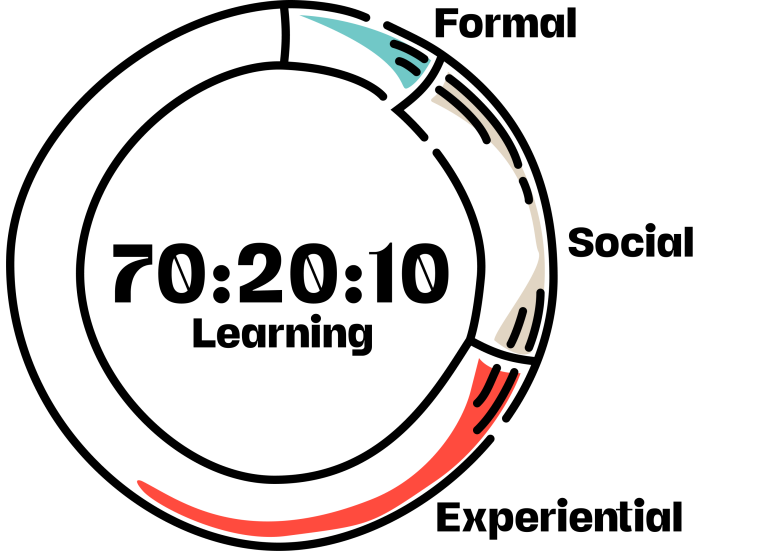Hey there, ever heard of the 70:20:10 Model?
It’s like the holy grail for designing killer learning programs from start to finish.
Here’s the lowdown: effective learning doesn’t just happen in the classroom or online. Nope, it’s all about getting your hands dirty with real-world experience, soaking up knowledge from others, and yes, a bit of formal education too.
So, what’s the big deal for instructional design?
Well, it’s easy to get stuck on formal learning, you know, the kind you get from courses and eLearning. But here’s the thing – that’s just the tip of the iceberg. According to the 70:20:10 model, there’s a whole lot more to it.

We’re talking about getting ready for on-the-job learning while you’re still in the classroom. That means prepping you for the real world by giving you practical skills and know-how that you can put into action right away.
And let’s not forget about building connections with your peers or work-mates. Because when you’ve got a crew cheering you on and sharing their experiences, learning becomes a whole lot easier.
But hey, don’t take our word for it. Studies show that most of your learning happens outside of formal training. Yup, it’s all about getting your hands dirty, soaking up knowledge from others, and diving headfirst into new experiences.
So, whether you’re a newbie in instructional design, a seasoned pro looking to up your game, or just curious about how learning really works, we’ve got you covered. Let’s dive in and explore the exciting world of learning together!
Experiential Learning with the 70:20:10 Learning model
To facilitate experiential learning, Instructional designers can:
Provide quick reference guides (QRG) for on-the-job reminders of key content, tips, and processes
Curate a collection of self-paced, practical on-the-job activities and further learning references
Provide a logbook/checklist of tasks for learners to complete at work

Social Learning
To facilitate social learning:
- Incorporate a ‘buddy system’ – where learners support one another and discuss their experiences in between or post formal learning events
- Schedule virtual ‘check-ins’ or start an online forum/discussion board
- Develop embedding activities for team leaders to facilitate in between or post formal learning events
The 70:20:10 Ratio
70:20:10 is not a fixed ratio [5].
A recent survey conducted by the Training Industry found that 55:25:20 is a more accurate split [7].

Regardless of the ratio, the point is: most learning occurs beyond formal training programs, through on-the-job experiences, exposure and social learning.
Formal learning is, however, an essential first step in building a foundation of knowledge, skills and understanding that learners will then expand and refine.
To enable this, instructional designers must consider how programs can best prepare and promote continuous learning.
Related Blogs and Articles
References
[1] WIOA Australia (2019). The Technical Competency Handbook: Knowledge, skills and competency development for water industry operations staff.
[2] Arets, J., Jennings, C., Heijnen V., (2016). 70:20:10 into action. Retrieved form https://702010institute.com/wp-content/uploads/2018/11/Primer-702010-into-action.pdf
[3] [5] 70 20 10 Institute (October 1, 2018). 5 Myths About the 70:20:10 Reference Model. Retrieved from https://702010institute.com/5-myths-702010-reference-model/
[4] Wroten, C., (September 4, 2014). How to Apply the 70:20:10 Model for Learning and Development. Retrieved from https://elearningindustry.com/apply-70-20-10-model-learning-development
[6] [7] Training Industry, Inc. (2018). Deconstructing 70-20-10.
FAQs - Frequently Asked Questions about the 70:20:10 Learning Model
The 70:20:10 Model is used worldwide as a general guideline for designing effective end-to-end learning programs. It proposes 70% of learning occurs through experiences, 20% through social interactions and 10% through formal learning. The model has been a ‘change agent’ to shape mindsets and learning practices, moving from traditional ‘chalk and talk’ to blended learning.
The 70:20:10 Model for Learning and Development was created by Morgan McCall, Michael M. Lombardo and Robert A. Eichinger, working for the Center for Creative Leadership. It is a general guideline for designing effective end-to-end learning programs. It recognises that most learning occurs beyond formal training programs, through on-the-job experiences, exposure and social learning.
When designing learning solutions, incorporate a combination of experiential, social and formal methodologies:
Experiential methods include on-the-job training and situational learning
Social methods include coaching, mentoring, feedback, social learning, buddy systems and collaboration
Formal methods include eLearning, simulations and lectures



